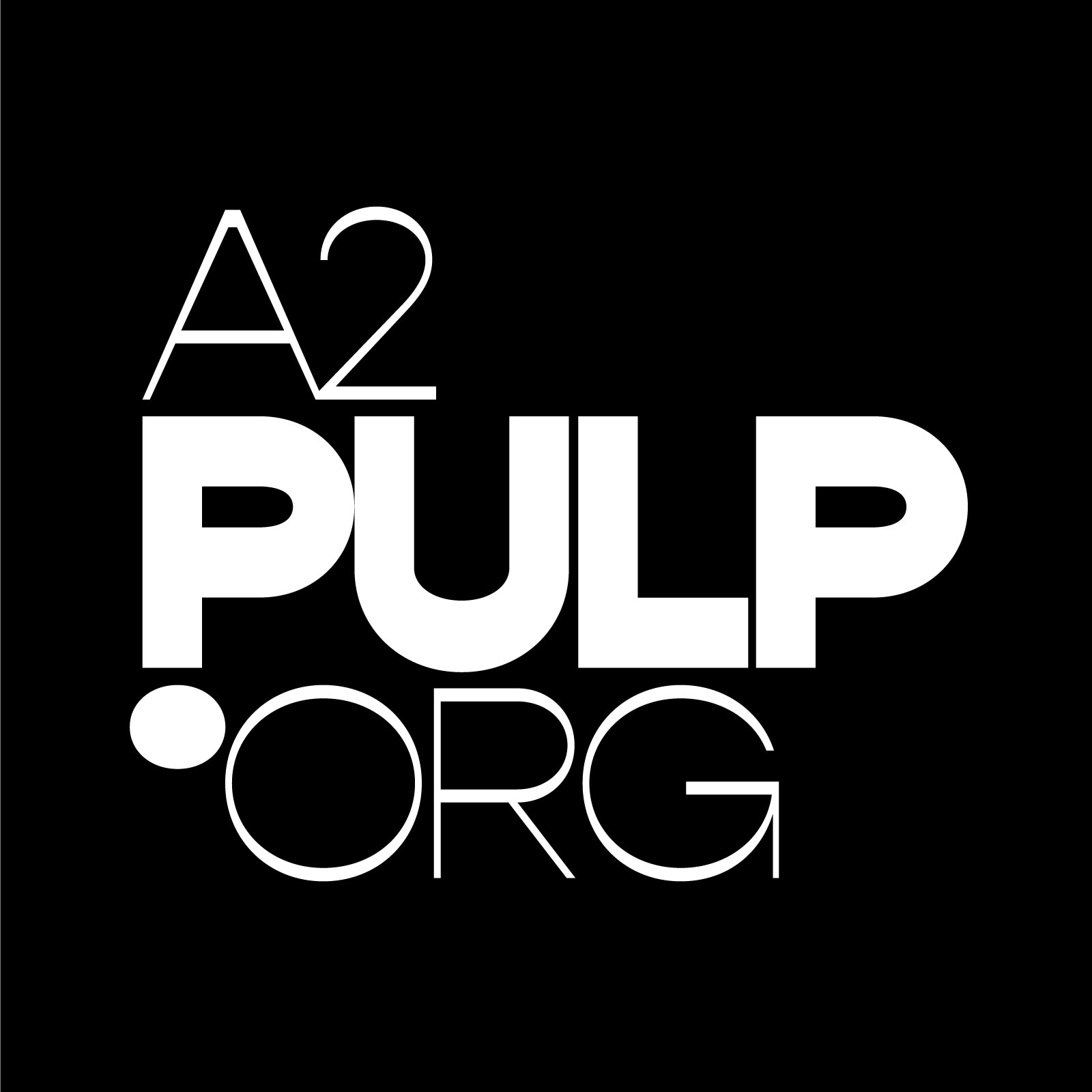Art Blooms in Hamtramck
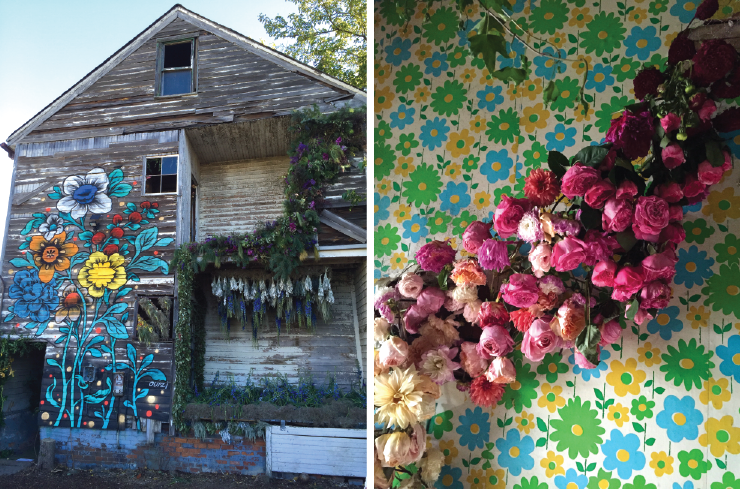
Crowds flocked to a vacant house on Dequindre St. in Hamtramck this weekend, all seeking an experience more likely to be found in a botanical garden or conservatory. The house, named simply Flower House, was created by Lisa Waud of Ann Arbor and Detroit-based Pot & Box, and features an amazing large-scale floral installation created using American-grown fresh flowers and living plants.
Waud and a team of floral designers from Michigan and throughout the country came together to create stunning floral installations throughout every room of a vacant and dilapidated house, sometimes extending from ceiling to floor or wall to wall.
During the three-day sold-out event, over 2,000 attendees each had 20 minutes to make their way through all 17 rooms in the house and revel in the experience. Walking through the dreamscape and floating from room to room was completely enchanting, and absorbing your surroundings was a delightful challenge. Your eyes roamed around in sensory overload trying to take in each room as a whole while also trying to notice all of the beautiful details tucked into every nook and cranny.
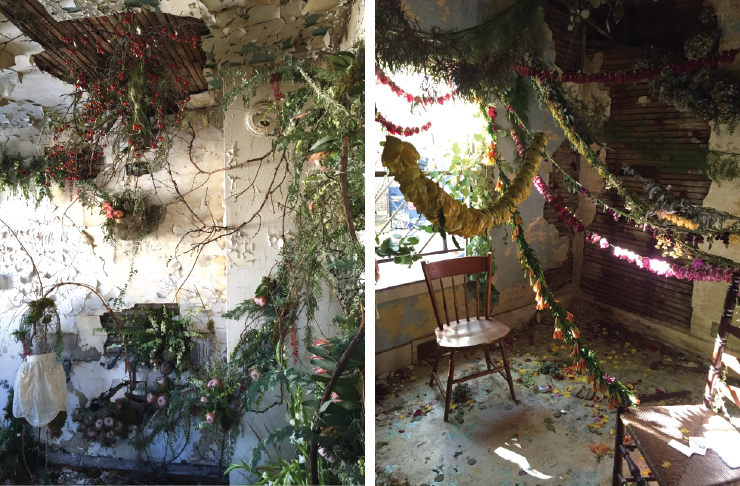
The bedroom housed a bed made of moss and branches, the bathrooms featured the prettiest, sweetest-smelling toilets you’ve ever seen, and the colorful old kitchen cupboards were adorned with greens amid the plates and silverware. Tulips dripped from the ceiling alongside peeling paint, interwoven marigolds created a playful shower curtain, and vegetables cascaded gracefully over crumbling walls. To complete the scene, the house was enveloped in the crisp smell of thousands of flowers on a chilly fall day while the admiring gasps of awestruck onlookers created a chorus to accompany the dreamy beauty of Flower House.
With the installation now ended, the house and its neighboring vacant house will be deconstructed and the materials will be repurposed. The land will then be turned into a flower farm and design space, in a continuation of Flower House's success in growing fresh beauty from a tired landscape.
Amanda Schott is a Library Technician at the Ann Arbor District Library.
Review: POP•X
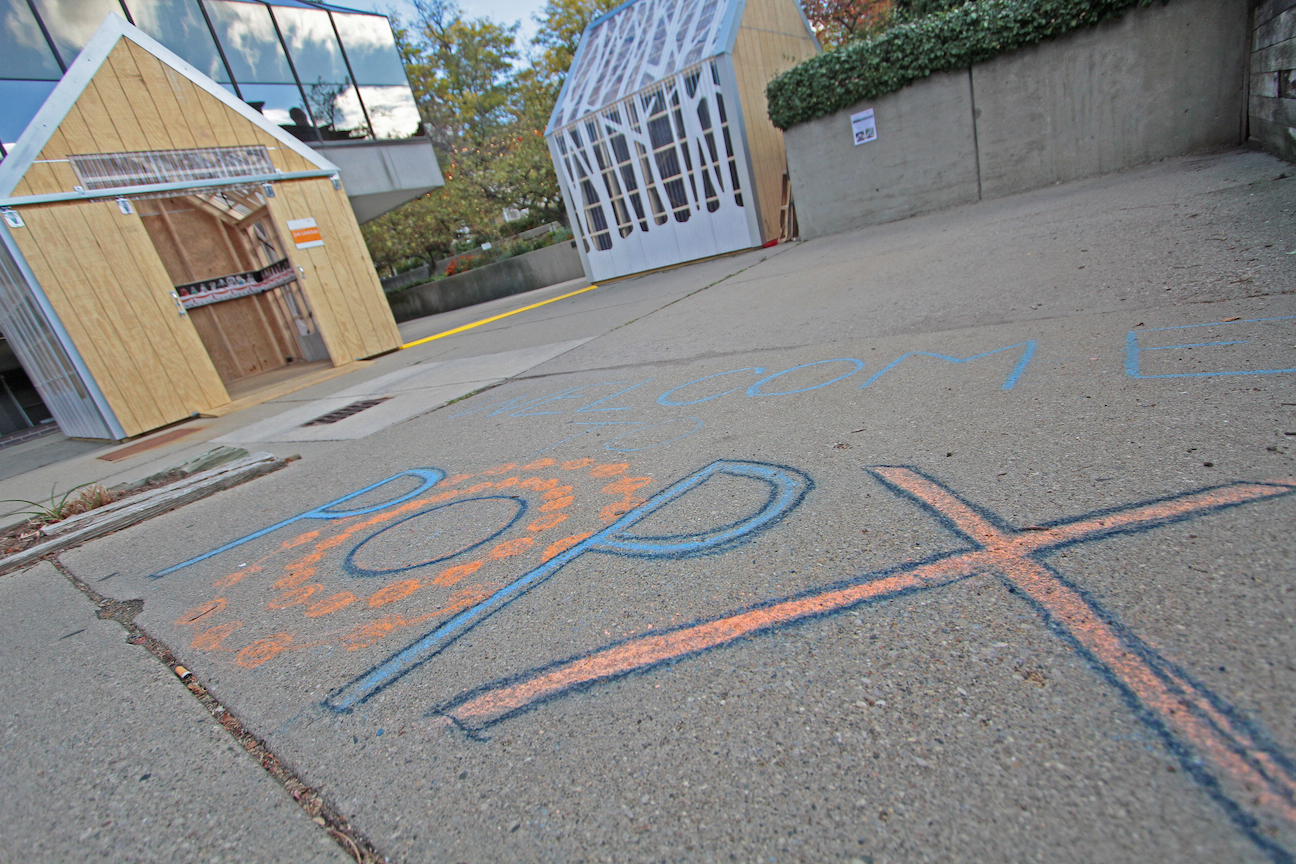
At the entrance to a 10’ x 10’ pavilion made of plywood and corrugated plastic at the edge of Liberty Plaza, I feel like I’m peering into some sort of mystical forest. Past the artificial palm fronds that frame the doorway, there are tall, mossy, finger-like artificial rocks awash in gentle blue light. Cottony clouds hang from the ceiling and recorded sounds of wind and woodland activity play softly.
A sweatshirt-clad, middle-aged man with a scraggly beard steps up behind me and I turn around. His expression is puzzled.
“Is there weed in there or something?” he asks.
“No,” I reply. “It’s an art installation.”
The pavilion containing Ann Arbor artist Nick Zagar’s forest landscape is one of eight pop-up structures comprising the Ann Arbor Art Center’s new POP•X exhibition in Liberty Plaza. Even at a cordoned-off POP•X preview event, it’s impossible not to confront the odd dichotomy between the plaza’s typical usage and the purpose it will take on for the next 10 days. Ann Arborites know the downtown park as a regular hangout for the homeless, the subject of repeated city council debate. Through October 24, however, it will be the site for POP•X, which organizers describe as the first step in a larger mission to create more publicly accessible art experiences in the Ann Arbor community.

All eight pavilions look essentially the same from the outside: unfinished wooden doorways at the front and back, with white silhouettes of trees crisscrossing the transparent sides and roofs. Inside, each pavilion is unique, tailored to the eccentricities of the artist or group who worked on it. Where Zagar fills his entire pavilion with his fantasy naturescape, artist Joe Levickas’ pavilion contains just a narrow band of illustrations of cartoon figures sitting down to a dinner party, like a surrealistic 50-person “Last Supper” stretching across three walls.
However, the most interesting pavilions at POP•X are those that directly engage with Liberty Plaza’s usual population and associated issues of economic disparity. Brenda Oelbaum’s somber installation uses black curtains to block out the light that streams into most POP•X pavilions, with a large mural inside presenting a quote Oelbaum’s grandmother adapted from Herodotus: “If we all put our troubles in bags and took them to the market to exchange them, upon seeing the problems of others we would gladly go home with our own.” Visitors are encouraged to write down their problems and leave them anonymously in a pile of small black pouches. Visitors may then read others’ problems and “purchase” them for a donation to the Ann Arbor Community Center or Mercy House, both charities supporting Ann Arbor’s hungry and homeless.
Just across from Oelbaum’s installation is a pavilion designed by the nonprofit Girls Group, which focuses on empowering young Ann Arbor and Ypsilanti women to stay in high school or college and avoid teen drug use and pregnancy. The group’s young participants have contributed a variety of works based on the concept of “home.” The most powerful work in the pavilion is a looping video of Dea Chappell, a fiery young Ann Arbor poet and high school junior, reading her poetry. “Welcome to black America,” Chappell almost sobs. “I can’t breathe…but black lives matter, right?” Standing by her untitled collage addressing themes of black sisterhood and protest, 17-year-old Skyline High School student Alexandra Cash tells me living in Ann Arbor has made her more aware of her “blackness.” “You can be really smart and get really good grades but still be on the lower end of the white kids,” Cash says.
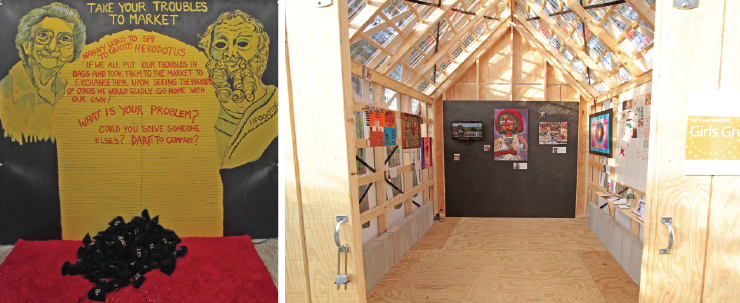
Ypsilanti artist Nick Azzaro’s pavilion provides POP•X’s most direct statement on Liberty Plaza’s usual inhabitants, and one of the most powerful statements in the show overall. At the center of Azzaro’s installation is “The Statue of Liberty Plaza,” a figure built from hundreds of tiny plastic army men and other military-related toys, posed in the form of Lady Liberty. The figure wears torn jeans, stuffed with newspaper and corrugated cardboard. In one hand it holds a copy of Groundcover News, in the other a sign reading “HOW ARE YOU TODAY?” On the walls surrounding the statue are professional portraits of individuals Azzaro met while spending an average, non-POP•X day in Liberty Plaza. The portraits are larger than life and most of the subjects grin broadly as they look directly into the camera, a white background behind them. Azzaro’s work encourages visitors to gaze upon the “huddled masses” we might otherwise ignore as we walk past Liberty Plaza, and to find a welcoming expression and a human story there.
Adjacent Azzaro’s pavilion is a more traditional representation of Ann Arbor’s art establishment. The Ann Arbor Women Artists’ pavilion, a collaboration between 30 of the 64-year-old organization’s members, is a delightful Art Nouveau-inspired outdoor picnic scene. Ruffled tissue-paper grass surrounds a painted pathway through the pavilion, suggesting a river. Plates are heaped with clay and Styrofoam fruits and vegetables, and dragonflies made of wire and tissue paper float overhead. It’s lavish, lovely and certainly more focused on craftsmanship and aesthetic beauty than political commentary.
But that’s part of why POP•X works so well. I was initially unsettled by the idea of an art show displacing Ann Arbor’s less fortunate for 10 days. But while POP•X’s organizers set out to bring art to the whole community, they’ve achieved something even higher: bringing our community face to face with itself. POP•X doesn’t whitewash Liberty Plaza for the enjoyment of some artistic elite, nor does it shut out more traditional voices from our local art scene. It forces anyone who explores all eight pavilions to confront diverse aspects of a complex town that is too often described in generalizations. Here, a Liberty Plaza regular may wander through the Women Artists’ picnic wonderland, or one of the well-dressed socialites I rubbed shoulders with at the preview event may take a moment to look into the eyes or listen to the words of Ann Arborites considerably less fortunate than him or herself. POP•X is many things: fun, sobering, beautiful, contemplative. But most importantly it’s responsible and respectful to the full scope of the community it represents.
Patrick Dunn is an Ann Arbor-based freelance writer whose work appears regularly in the Detroit News, the Ann Arbor Observer, and other local publications. He can be heard most Friday mornings at 8:40am on the Martin Bandyke morning program on Ann Arbor's 107one.
POP•X runs Thursday, October 15 – Saturday, October 14, 2015 from 10am to 8pm at Liberty Plaza Park, 255 East Liberty St., Ann Arbor. To learn more visit popxannarbor.com or the POP•X Facebook event page. POP•X is free and open to the public.
Preview: POP·X
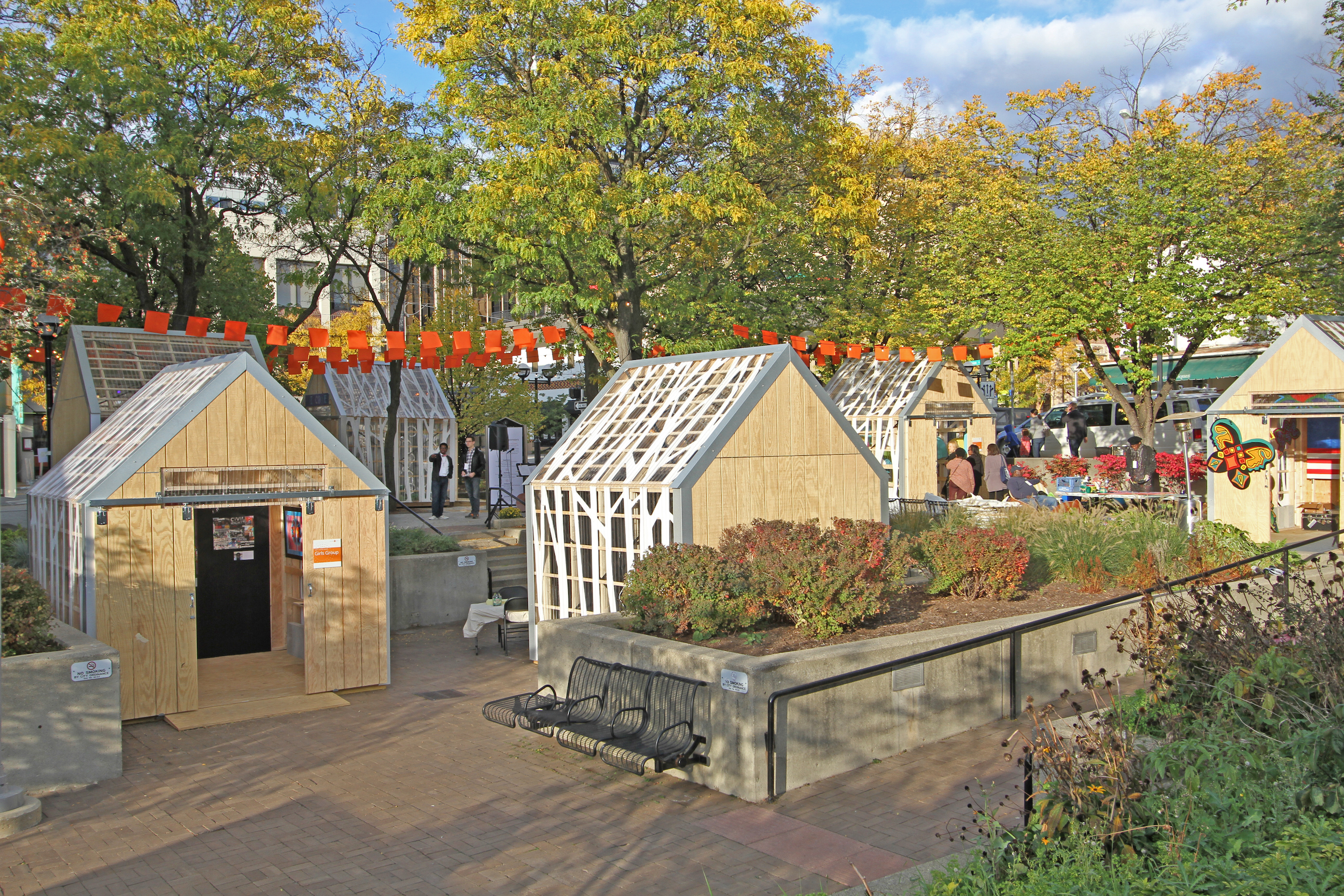
Art is popping up at Liberty Plaza that aims to expand the reach of creativity in our community. The 2015 inaugural POP•X Festival, organized by the Ann Arbor Art Center, will run from Thursday, October 15 through Saturday, October 24, 2015. This 10 day visual arts festival will include nine 10’ x 10’ structures or “pavilions,” which will each house a collection of works focused around various central themes. The work in each pavilion is created by one artist or a collaboration of artists. Artists will be on site throughout the event and many will be facilitating interactive activities.
Here are the artists and clues to what you’ll find inside their pavilions:
- Chazz Miller: butterflies, transformation and vibrancy.
- Nick Azzaro: familiar faces.
- Ann Arbor Women Artists (AAWA): picnic wishes.
- The Girls Group: home.
- Joe Levikas: the dinner guest.
- Brenda Oelbaum: bag your troubles.
- Kate Robertson: voyeuristic spaces within spaces.
- Nicholas Zager: an interior landscape for the senses.
- The ninth is the Ann Arbor Art Center’s information pavilion.
This event is packed full of art opportunities for the whole family. Stop by anytime on Thursday, October 15 to paint a butterfly with artist Chazz Miller. Then watch for these butterflies to appear around town. Other events throughout the 10 day festival will include Pop-Up Theater, Art for Innovators (a lunchtime discussion series at AADL), Back to the Future Day, Nerd Nite artist talks, live music (daily from 5–7pm), Family Drop-In: Cardboard Challenge, and special activities geared particularly towards kids. And, sign up to participate in one of the Pop-Up Picnics on Sunday, October 18 with local “celebrity” mystery guests and conversation cues provided by CivCity.You can see the whole lineup on the POP•X calendar.
Anne Drozd is a Production Librarian at the Ann Arbor District Library.
POP·X runs Thursday, October 15 – Saturday October 24, 2015 from 10am to 8pm at Liberty Plaza Park, 255 East Liberty St., Ann Arbor. To learn more visit popxannarbor.com or the POP•X Facebook event page. POP•X is free and open to the public.
First Fridays Ypsilanti: Bee-decked in Art
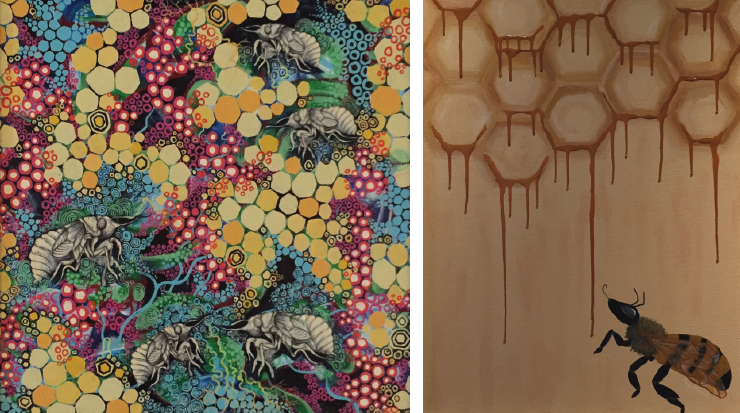
First Fridays Ypsilanti, the monthly art-walk that invites locals on self-guided art tours through the city, generated buzz this September using bees as a theme for artist inspiration. In honor of Ypsi’s third annual Festival of the Honey Bee, local cafés, restaurants, and galleries became temporary homes to some bee-autiful art pieces, ranging from the truly enormous to the wonderfully weird.
It seems as if no work was too big or too small, and no medium too strange for this art crawl, and the result was a veritable explosion of artwork branching out in unexpected directions from the unified bee theme.
Some artwork hung traditionally in frames, like the pieces on the walls at Beezy’s and Café Ollie, which ranged from collages of paper bees exploring paper leaves to photographs of real bees swarming in their hive.
Some artwork hung from the ceiling by string, like the bizarre (bee-zarre?) mixed-media piece “Lady Bug Lady,” a doll covered in glitter and spots, connected to the theme by a set of sparkly antennae peeking through the doll’s purple hair at the 22 North Art Gallery.
At the Bona Sera Café, a massive, lifelike black-and-gold papier-mâché bee looked like it had just flown in and settled on the brick walls.
And, of course, the art crawl wouldn’t have been complete without some truly solid bee puns, like the whimsical piece titled “Let’s Bee Friends.”
The bee-related installment came down at the end of September. Plan your visit for the next First Friday on November 6th.
Nicole Williams is a Production Librarian at the Ann Arbor District Library and is terrified of bees.
Review: UMMA The Art of Tyree Guyton and DAAS What Time is It?

It takes exceedingly broad shoulders to craft an art that suits a specific time and place. This is because art is, despite itself, time specific. Art, however, also paradoxically seeks a timelessness that makes the work somewhat ephemeral to its actual situation. And that in turn makes grappling with the work's creativity a tricky proposition.
Yet perhaps not so much with two artful events taking place in Ann Arbor through this Fall 2015 season. The University of Michigan Museum of Art's The Art of Tyree Guyton: A Thirty-Year Journey and the U-M Department of Afroamerican and African Studies Gallery DAAS What Time is It?: Tyree Guyton, New Work have teamed up to give us a keen sense of how this contemporary Detroit artist has managed to grab the zeitgeist of our time by the throat to show us a controversial reflection that not all Detroiters prefer as a mirror. Add its Ann Arbor angle-and the art of Tyree Guyton is a unique homegrown Southeast Michigan adventure.
As far back as the late 1980s, one of Ann Arbor's most courageous champions of modern art, the late-Jacques Karamanoukian, was enthused (although overwhelmed might be a better way to put it) about Guyton's work-as well as by extension, Guyton's grandfather, Sam Mackey.
Karamanoukian-whose Gallerie Jacques loft and Kerrytown Le Minotaur Gallerie-served up a steady diet of Surreal Art and Art Brut in the 1980s and 1990s, seemingly met his match with Guyton's audacious Detroit-based Heidelberg Project. And in this, Karamanoukian has proven to be much farther sighted than the city of Detroit itself. It's therefore to the credit of the UMMA that The Art of Tyree Guyton: A Thirty-Year Journey skillfully traces this undertaking.
Started in 1986, Guyton's Heidelberg Project is a remarkable example of environmental art whose social and political intent is so gripping, it effectively dominates its ground with a vivacity few other contemporary artworks can match. Located in Detroit's McDougall-Hunt neighborhood, the artwork's evolving intent has been to heighten awareness of the city's urban decay and the State of Michigan's benign neglect in caring for the its inner-district. But it also isn't exactly a way to make friends and influence people in positions of power.
Now if Guyton and Mackie had been intent on crafting some latter-day cathedral or modernist architecture, they might have been able to avoid antagonizing Detroit's officials. But as both The Art of Tyree Guyton: A Thirty-Year Journey and What Time is It?: Tyree Guyton, New Work both show us by example-this wasn't and isn't happening.
Because it's likely not so much the Heidelberg's intent that's drawn the ire of Detroit (after all, both the Coleman Young and Dennis Archer administrations have bull-dozed chunks of the project with a decade of vandalism taking care of many other buildings). Rather, it's the kind of art that's the real problem. Both Mackie and Guyton (the former by disposition and the latter by inclination) are proponents of one of Modernism's most controversial forms of Art Brut-or to borrow from Karamanoukian's favored and vastly telling term: Outsider Art.
Guyton's most serious offense-and one aided and abetted by his grandfather, Mackie-has been the playing of art rules by not playing the social rules. Sam Mackie's two 1992 untitled wax crayon on illustration board and crayon on oil cloth male portraits at the UMMA are prime examples of an Art Brut that's 100 percent inspiration and zero percent artifice.
They might be confused for the art of a young child, but this is also the magic in the crafting. These two roughly drawn pictures crafted in Mackie's 90s (he lived 1897-1992) are channeling pure inspiration and this is an aesthetic that can't be taught. Indeed, once lost it is seemingly impossible to retrieve; Picasso tried all his life. And it's this profoundly naïve insight that makes Art Brut such a powerful form of art.
Guyton, by contrast-and DAAS' What Time is It? shows us this with a choice 16 artworks-is infinitely more polished while also paradoxically retaining its outsider edge. If anything, what Guyton shows us in this remarkable primer is how painstaking it must be to maintain this sort of Brut naivety. He's still got it, so to speak, by studiously not losing it.
For example, 2015's mixed-media “The Twelfth Hour” at the DAAS Gallery fuses together a handful of found elements with an artful balance whose placement belies Guyton's rush of inspiration in pulling his compositional elements together. A piece of green rectangular wood set horizontally to represent the face of a clock, Guyton had painted (through four applications) numerals with two overlaid pieces of black and white wood for big and little hands breaking the work's interior visual plane behind overlapping patches of police security tape.
We need make only two observations: First, the clock's hands aren't pointing at twelve; and second, it's the eleventh hour that's cautionary. For as the work tells us by abstraction-with the title's timely assist-twelve is beyond the nick of time. Hence, given the roughness of its creation and appearance, coupled with its title, Guyton pictorially articulates a pungent political statement.
Going back momentarily to the UMMA's The Art of Tyree Guyton: A Thirty-Year Journey, it's this very lack of aesthetic compromise that raised the disdain of Detroit's political establishment. Guyton's Heidelberg Project is too uncompromising to stand on its own because we're not talking Venus on the half-shell, here.
As soon as Guyton began crafting his mixed-media environmental art with exceeding large found objects (obviously considered detritus by its opponents), he passed the bound of artistic delicacy. As Guyton's UMMA Thirty year Journey clearly shows us: the gloves were bound to come off with each found object nailed in place: Take Guyton's “House of Soul” with Motown vinyl LPs (torched in November, 2013) or “The Doll House” with its myriad plastic baby dolls stapled to the exterior (torched in March, 2014). Both houses-like the seven other environmental mixed-medias burnt in these last few years-could be perceived as eye-sores.
But they're not eye-sores. Like it or not, they're art. For Guyton has made them art-and by the reckoning of Marcel Duchamp; father of neo-Dada, which the Heidelberg Project is a clear example-it's the artist who decides what is art.
It's not what politicians think-nor what art critics think--nor citizens, for that matter. As Jacques Karamanoukian well knew before most of us were aware of its existence: The Heidelberg Project (with its long-range goal of being an art center, museum, and artists' colony) is not art for art's sake. It's art for everyone's sake. Tyree Guyton just happens to be Detroit's messenger.
John Carlos Cantú has written extensively on our community's visual arts in a number of different periodicals.
University of Michigan Museum of Art: The Art of Tyree Guyton: A Thirty-Year Journey will run through January 3, 2016. The UMMA is located at 525 S. State Street. The Museum is open Tuesday-Saturday 11 a.m.-5 p.m.; and Sunday 12-5 p.m. For information, call 734-764.0395.
U-M Department of Afroamerican and African Studies Gallery DAAS: What Time is It? Tyree Guyton: New Work will run through November 6. Gallery Dass is located at Haven Hall, Room G648. The Gallery is open Monday-Friday, 1 to 5 p.m. For information, call 734-764-5513.

